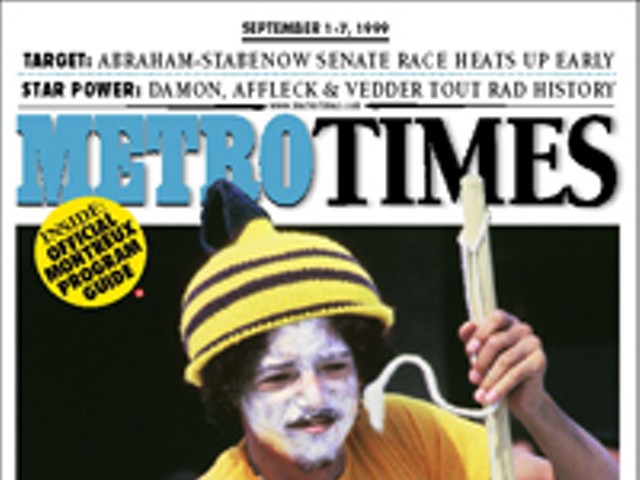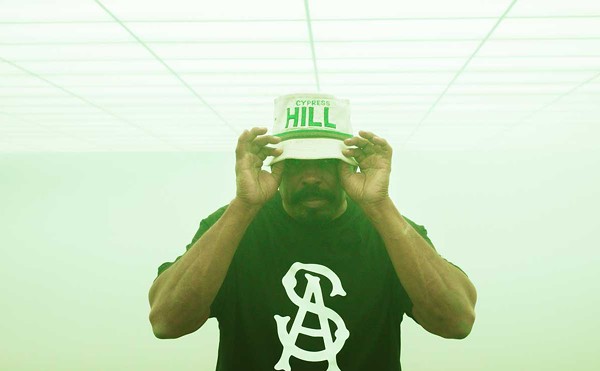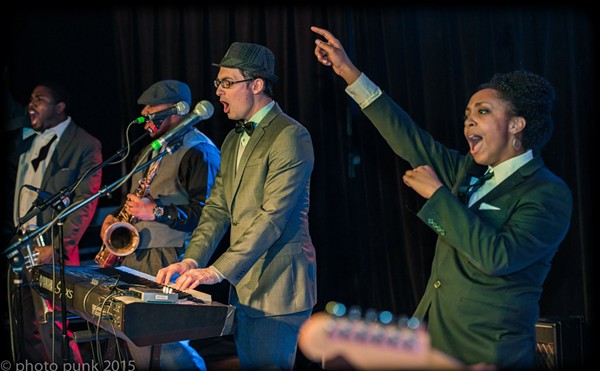For the music lover, the annual outpouring of music from the Ford Montreux Detroit Jazz Festival and the Ann Arbor Blues and Jazz Festival can’t help but to uncork the wine of music remembered. Four Metro Times jazz heads — with over 100 years of jazz testifying among them — pour some of theirs.
To hang on the scene is to soak up stories going back, way back. After a while, you can imagine having been there the night at the Graystone Ballroom when McKinney’s Cotton Pickers introduced "I Want a Little Girl," or at Baker’s Keyboard Lounge for Art Tatum’s last luminous set. Of course, you identify with the Bluebird Inn: If bebop was a bomb, the Bluebird was its ground zero in Detroit. It’s where Miles settled in to kick his habit, where Charlie Parker dropped by to jam, where ElvinJones went from a meek aspirant, honored "even to speak to the cats," to become one of the giants. Jones-the-giant is a legendary scene in city jazz lore: His drums were in the front of the club; obliging the gaggle of fans too young to come inside, he opened the venetian blinds to put on a show for them. You mentally insert yourself, Zelig-like, into the scene alongside Roy Brooks and Louis Hayes.
You can’t help but be riveted by stories like the one pianist Harold McKinney tells of a wee hours, early-’50s encounter between saxophonists Sonny Rollins and Yusef Lateef at the West End Hotel. Lateef propped himself against the piano, head bowed in concentration, as Rollins, standing in the doorway, opened their dueling tune.
"He played and sprayed Yusef with all kinds of ‘Brdtdtdtdtdrbr dtdtdtdtdrsss,’ and he played three choruses of blues in 64th notes and 128th notes, and every time he’d goose Yusef with the horn, hunch his horn toward Yusef. … And then after he got through, he stepped back, and he looked at Yusef almost as if to say, ‘Well, whatcha gonna do about it?’ And Yusef fumbled a little bit, picked his horn up, and three measures of music went by — nothing. And Yusef said, ‘Whoooooooooo,’ and people said, ‘Huh?’ They were startled. "Whooooo doooo doooo dooooooo." and then a snicker ran across the audience. Then "Hooooo dooo dooo dooo dooo dooo." … Yusef did three choruses, and by the time he got through people were hollering and laughing, and I looked and Sonny Rollins had disappeared out the back door and I said to myself, ‘Yeah, he was telling Sonny Rollins it ain’t how many notes you do, ithow much music you put in the notes.’ And that was a lesson for me, of course, too."
As for us all. —W. Kim Heron
Anybody serious about jazz in the late ’50s followed John Col trane’s developing genius in the Miles Davis groups. But his own recording sessions, including Soultrane on Prestige and Blue Train on Blue Note, showed that he had even denser beauty in mind. Soon he was off on his own, getting more and more into the business of ripping apart our expectations. So we awaited his visits to Detroit in the early ’60s as if he were the pope of some sexy, hip religion. When the John Coltrane Quintet first played at the Minor Key on Dexter, neighborhood hipsters dressed in fine suits and silk ties, flashy ladies on their arms; scraggy beatniks, throngs of college kids, many just curious, came out in droves. In our memory, the blistering, muscular, blues-inflected tenor saxophonist who had given new life to "My Favorite Things" and the soprano sax in one fell swoop could be counted on for the biggest rush of all — little did we know. Trane’s new group took no prisoners. The old Miles-Trane yin-yang was replaced by a new tension between the leader’s 15- or 20-minute solos — during which all manner of sonic testifying came down in one apocalyptic avalanche — and the plaintive banshee wailing of reedman Eric Dolphy, whose personal sound of music was understood by few in the house. Elvin Jones beat all holy hell out of the drums till at one moment Trane seemed to be on his knees, pleading with the god of sound for deliverance. Those who stuck it out were shaken, changed forever. It was painful and profound. We grew to love it.
Spring 1965: The New Thing was in full bloom and the Artists Workshop was where it put down roots in Detroit. Trumpet sensei Charles Moore’s band of freethinkers, dedicated to the proposition that all notes were created equal, were taking inspiration from Coltrane, Archie Shepp, Jackie McLean and Miles’ quintet with Wayne Shorter and Tony Williams. One warm Sunday, with news of Cannonball Adderley’s sextet in town, a bunch of Workshoppers, led by Charles and poet John Sinclair, piled into two gas-guzzlers and headed for a now long-forgotten club on the east side where Cannon’s men were rehearsing. Our mission: Make contact with Charles Lloyd, Adderley’s young tenor saxophonist, and hopefully spirit him off to the Workshop for some impromptu blowing. After a few uncertain moments, Lloyd agreed to come along. Rays of afternoon sun gave the Workshop a monastic look as Moore and Lloyd felt each other out on Sonny Rollins’ "Doxy," with John Dana on bass and Ron Johnson on drums. It amazed us that the feel of this new music, its intoxicating sense of freedom and excitement, could be sparked by musicians who had met each other just minutes earlier. Tune after tune, peak upon further spontaneous peak, they played until the sun went down and made believers of us all. —George Tysh
The 1972 Ann Arbor Blues and Jazz Festival was held outdoors in a field next to one of the high schools. It was a three-day affair and my first big festival. Pharoah Sanders played along with a stellar list of blues artists (Howlin’ Wolf, Sippie Wallace, Muddy Waters). The first major moment came Friday night. After having spent the day out in the sun imbibing beers and smokes I was flat on my back among the legs of the crowd. I swore I wasn’t going to get up. Then Sun Ra and his Arkestra came on. The band raged like a band of stampeding elephants — a heavy beat with horns wailing above the cacophony. After a few minutes the music forced me to stand up to witness the band that made such wonderful noise. Then I got the visual assault with the flowing robes and wild hats and intergalactic dancers.
On Saturday, the Art Ensemble of Chicago introduced me to a softer version of playing out. They were just as theatrical with painted faces and African garb, but the music was at times dense and complex, at other times ethereal. This set was also the first big show with trap drummer Don Moye as part of the group. For me, the highlight was the piece "Odwallah," which closed their set. The theme is carried on the two bass saxophones that Joseph Jarman and Roscoe Mitchell had set up on either side of the stage like bookends. After all the wild freakishness, "Odwallah" was a simple swing tune. They swang and danced offstage until just one sax was left to play the unadorned melody. End set.
I’ve always felt that the Pyramid stage was the best Montreux Detroit jazz showcase and the most memorable festival set I ever saw there was the 1991 Gwen Laster-Marlene Rice band. Laster and Rice, both electric violinists who left town shortly after, were at the top of their game playing tight ensemble passages, and soloing with a mix of sharp riffs and long melodic lines. Backed by a strong rhythm section and saxophonist David McMurray, who contributed his labyrinthine chunks of music, the set was exciting, adventurous and unusual. —Larry Gabriel
The first time I heard alto saxophonist Larry Smith was at Bert’s Marketplace. He had a tough rhythm section that included pianist Teddy Harris, bassist Rodney Hicks and drummer Larry Cleaver. The night before I had watched, for the first time, Round Midnight, a film about an embattled American jazz musician in Europe. When I saw Larry on the bandstand he reminded me of Dale Turner, the character that saxophonist Dexter Gordon portrayed in the film. Like Dale Turner, Larry has stockyard shoulders, a raspy voice, and had done plenty of hard living. His music had a humanistic quality as if each note told a story. The blues he played was all gin and tonic. As he played, I wondered if a hard life was the core of good jazz?
I mustered the nerve to go over and talk to Larry. He was sitting at the table laughing with Rodney Hicks, who was eating fried chicken wings. I told Larry that I was a jazz journalist, and I was floored by his music. I asked if he would let me interview him for an article? He said that he charged $100 for an interview, and that I had to guarantee him that it would be a cover story. I left Bert’s that night thinking that if Larry had been around during the filming of Round Midnight he would have been a perfect understudy for Dexter Gordon.
Bert’s Marketplace is known for its legendary tenor saxophone battles. The one that sticks out in my mind was between Donald Walden and James Carter. It happened on the weekend that Donald debuted his new group, Jazzworks. James Carter walked in carrying his tenor. He was sharper than a new razor. James placed his horn on the table where Donald’s group was recuperating from the first set. James removed his overcoat, walked over to Donald and hugged him. James sat in during the second set. On his first solo he had the crowd screaming like they had been touched by some holy spirit. Donald stood offstage patting his right hand against his right thigh with a contemplative expression on his face.
When James finished, he gave Donald that now-deal-with-that-look.
For the second tune, Donald called the ballad "A Portrait of You." By the time he finished the first chorus, the crowd was transfixed and savoring each note. This time Donald and James didn’t spend the entire set trying to gun each other down. It started as a tenor battle, and ended as an exchange of musical ideas that embodied all the richness and warmth of prodigal son challenging his father. —Charles L. Latimer






